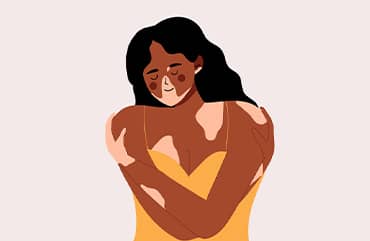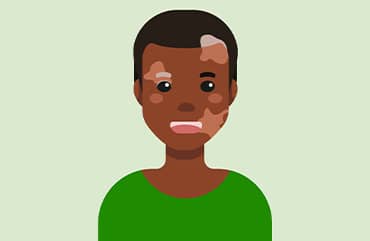
Let's understand Vitiligo
Vitiligo, commonly known as leukoderma and सफ़ेद दाग, is an auto-immune disorder where the immune system starts to affect and damage the active cells of the body. Herein, the immune system becomes hyperactive and damages melanocytes responsible for developing melanin pigment in the body. Therefore, any damage to melanocytes decreases the pigmentation of melanin. Melanocyte cells in the body produce melanin, a pigment that provides the skin it’s color. Reduced production of melanin makes the tone or color of the skin uneven resulting in white vitiligo patches on the skin.
Major types of Vitiligo
1. Segmental Vitiligo
Between 5 and 16 percent of vitiligo patients have this, where white spots only form on one side of the body, such as one arm or leg. Hair color fading is usual.
Segmented vitiligo can appear at a young age, progress rapidly for six months to two years, and then stop.
2. Non-segmental Vitiligo
Also known as bilateral or generalized vitiligo or vitiligo vulgaris, nonsegmental vitiligo manifests as pale skin patches on both sides of the body. The earliest symptoms may appear on the hands, wrists, eyes, lips, hands, or feet.
The type of vitiligo a person has can affect the course, severity, and effectiveness of treatment of their condition. Therefore, the diagnosis must be proper to create an appropriate treatment strategy.

Signs & Symptoms of Vitiligo
Seek medical advice if you notice these symptoms.

Hearing loss and vision Issues

Loss of color in the mouth and nose

Premature greying or whitening of the hair

Eyebrows or eyelashes turning white and losing color
What leads to
Seek medical advice if you notice these symptoms.

A genetic mutation or alteration to the body’s genetics can impact how well the melanocytes work. For example, more than 30 genes can make you more likely to get vitiligo.
Frequent physical and mental stress experiences on the body, particularly after an injury, may alter the amount of pigment the melanocyte cells produce.
Conditions, including exposure to harmful chemicals and UV light, can impact the melanocyte cells’ ability to operate.
The immune system misidentifies healthy cells (melanocytes) as harmful bacteria or foreign invaders and produces antibodies that attack the melanocytes.
Our Patient's Journeys
I had a small spot on my feet that started spreading to other body parts. I visited a medical professional and started taking allopathic pills. However, I found no relief, and the patches kept spreading. Later, I visited Yogratna and started my recovery with a team of doctors. I was apprehensive about my condition, but my white patches have begun to disappear with continued support for almost nine months and strictly adhering to the prescribed diet.
My daughter, Aafia, had a patch of सफ़ेद दाग on her cheek at the age of 11. I struggled for proper guidance at many places, including PGIMER, Chandigarh, Kalka, and Panchkula, but I didn’t find relief in her condition. Now after one year of dedicated care and attention at YogRatna, she is completely alright. She strictly adhered to the guidelines and dietary routine as suggested.


